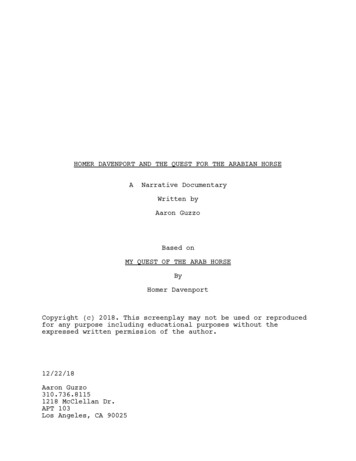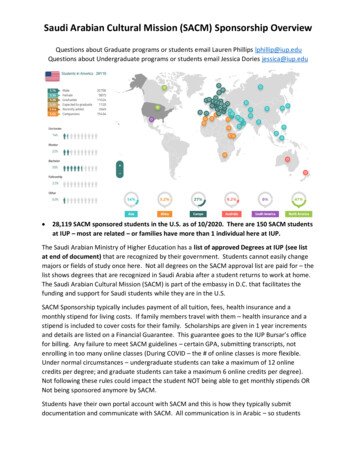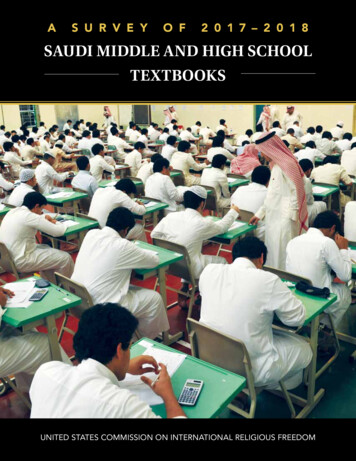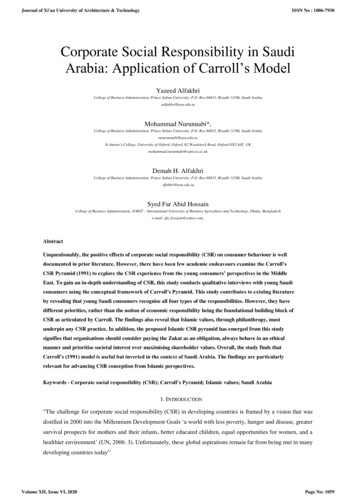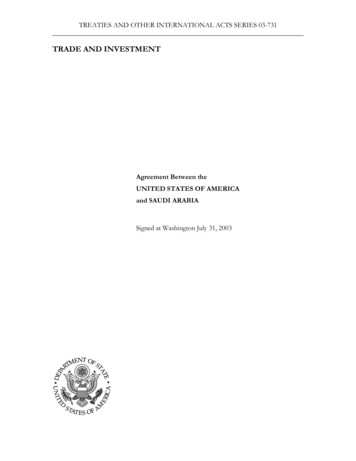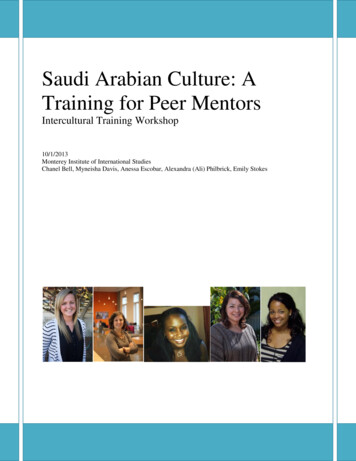
Transcription
Saudi Arabian Culture: ATraining for Peer MentorsIntercultural Training Workshop10/1/2013Monterey Institute of International StudiesChanel Bell, Myneisha Davis, Anessa Escobar, Alexandra (Ali) Philbrick, Emily Stokes
INTRODUCTIONThis workshop will be offered to students at a large state university in Texas. Thesestudents will be working as peer mentors and communication partners with incoming SaudiArabian international students. The students who participate in this workshop will be able tobetter communicate and assist their international partners in their transition and adaptationprocess into a new culture. In order to succeed in this process, the students themselves mustexplore their own culture as well as Saudi Arabian culture.The purpose of this workshop is to provide students with the knowledge of Saudi Arabianculture as well as the necessary cultural competence to work efficiently in a global world.Culture is so much more than what is on the surface. During this workshop we will delve deeperinto the understanding of culture using creative and informative sources. We will conduct livelydiscussions, play games, and utilize relevant film clips to best convey the importance of culturalcompetency.From this workshop, participants will develop skills to better analyze cultural approachesto time, emotion, power, decision-making, verbal communication and non-verbal gestures.Culture significantly impacts our ability to communicate efficiently. Miscommunicationswhether verbal or non-verbal, commonly occur due to a lack of true understanding andacceptance of cultural practices that don’t align with our own cultural norms. Through theleadership of a highly trained professional staff of international advisors to Saudi Arabianexchange students, participants will have gained essential skills to interact with Saudi Arabianstudents in an insightful and non-judgmental manner.2
ACTIVITY ONE: THE LANGUAGE GAMEThis activity begins by one presenter asking the class to get out a pen and paper. Thenthe presenter abruptly begins speaking in a foreign language, preferably a language that most ofthe audience does not speak or have experience with.1. The presenter (in the foreign language) asks the group to number their paper from one to five.2. The presenter then tells them what to write in each line; their name, their age, their hometown,etc., all while speaking in a foreign language.After this has been completed, the group is asked to reflect on their experience:1. What was that experience like?2. Were able to follow along?3. Did you feel overwhelmed? Confused? Frustrated?The object of the language game is to help the group of Peer Mentors empathize with theSaudi Arabian students they will soon be working with. It is important to point out after thisactivity that how they just felt is what many newly arrived students may be feeling.ACTIVITY TWO: MINEFIELDMinefield is the next game, and the instructions for setup and game play are below:PROPS AND SET UP:Several sections of game ropes, lots of objects of various shape and size, 4 cones andblindfolds. Mark the boundaries of the minefield using two game ropes (or one if it is longenough). Average minefields are amoeba shaped about 2m wide by 8m long. Use 2 cones tomark the entrance and 2 cones to mark the exit (usually a narrow section at either of the longends). Deposit the objects haphazardly within the boundary ropes; these are the obstacles.FRAMING/TASK: Each group member must navigate the minefield without sight. Outside groupmembers are encouraged to guide their peers through the minefield.3
RULES: Each participant may only enter the minefield once If a group member touches an obstacle in the minefield (including the boundaries) they becomefrozen To become “un-frozen” the frozen individual must be touched by another person in theminefield If two people are connected when an object is touched, both participants are frozenINDIVIDUAL, GROUP AND SAFETY CONSIDERATIONS: No running or jumping while in the minefield or blindfolded Keep this activity in the shade on hot days as it has the potential to take a significant amount oftime.VARIATIONS: A time limit can be imposed on the group A dividing rope can be used to split the minefield in two. Participants who have not completedthe minefield can only go up to the divider, and participants who have completed the minefieldcan only go back to the divider.POINTS FOR DISCUSSION: How comfortable were you being a leader/guide? How comfortable were you being lead? When have you been in a situation in which you had to lead someone or were leadthrough something you didn’t know much about? What helped you through the minefield? How can you use what helped you here when it comes to leading someone else?After a large group discussion, break the group up into pairs in order for them to discussthe relevancy of the activity to their Peer Mentoring program. The debrief of this activity must bethorough in order for the audience to fully connect the ideas to their program.WHAT IS CULTURE?Culture can be thought of as the characteristics of a particular group of people, defined byeverything from language, religion, cuisine, social habits, music and the arts. Culture in otherwords is a system of knowledge that structures perceptions and shapes behaviors. From themoment we are born we begin to form an identity, a pattern of thinking, feeling, and acting thatbegins with the family. Much of our identity and our actions have been taught to us by theoutside (school, neighbor, religion, family, etc.). These outside influences stem from particular4
cultures, which have their own set of rules and traditions. Today, there is not just one culture thatmakes up an individual. Culture is multilevel. Political groups, professions, religion, ethnicityand social groups are cultures within themselves which contribute to a person’s individualidentity.Culture can also be looked at as something dynamic and active. Through time anindividual culture can form a new culture. Interactions with others, migration, climate and evenwar, can make culture mobile. When one culture moves into another culture, both cultures mayexperience major challenges to adapt to one another. Understanding another culture can serve asa protective mechanism for an individual who is moving from one culture into another. For most,culture is looked at by its outside attributes. Food, clothes, religion, gender, age and ethnicity areattributes that are visual to the eyes. Culture goes further beyond what the eye can see.ICEBERG MODELIcebergs are pieces of ice found in oceans that range from the size of a car up to the sizeof a large mountain. To facilitate a discussion, culture can be compared to an Iceberg becauseonly a small portion of the iceberg can be seen above the water. What is visual in culture isgreatly influenced by culture aspects below the water for example, religious beliefs influenceholiday customs and notions of beauty influence the arts. Understanding how culture works canhelp someone understand and adjust to a new culture, which is an important concept for our peermentors.5
CROSSING BORDERS DOCUMENTARY:Crossing Borders is a seventy-minute documentary that follows four Moroccan and fourAmerican university students as they travel together through Morocco. The relationships formedthrough shared experiences contrast sharply with the media-shaped views Americans andMuslims have of each other. The clip chosen from this video was a scene in which the Moroccanstudents are having a heated discussion about life in Morocco. After the discussion, theAmerican students explain how uncomfortable they felt hearing the Moroccan students denyeach other. Debrief for this clip is on cultural interactions. Have students discuss their reactionsto the clip and how they would react to a situation similar.6
LEWIS MODELThe Lewis Model of Culture divides cultures into three types:Linear-Active, Multi-Active and Reactive. Linear Active cultures are detail and job oriented,very direct and planners (i.e. Germany). Multi-Active cultures are relationship-oriented culturesthat react out of feelings not facts (i.e. Mexico). Reactive cultures are people oriented, very politeand indirect and value in personal contact (i.e. Vietnam).This model will be used to aid in the introduction to culture and the multiple elements ofculture in general. After the model has been shown, presenters should ask students to guesswhere the US falls and where Saudi Arabia falls on the scale.The presenters should then show the model and where countries fall on the chart. Explainthat these are things to keep in mind when working with Saudi students. Saudi students are moregeneral in their planning, very emotional in their decisions and truly value relationships. Thetraining should provide time here for students to discuss other aspects that will be importantwhen working with Saudi students. Next, have students share what they know about SaudiArabian culture, any beliefs, stereotypes, etc. This is important to identify so that students can be7
aware of any pre-conceived ideas they may be holding surrounding Saudi Arabian culture andSaudi students.SAUDI ARABIAN CULTURETo introduce the topic of Saudi culture, the presentation will include a Poll Everywherepoll at this point in order to ask the students how they identify themselves; as a member of acommunity or as an individual. After the above points and discussion, a Poll Everywherequestion can be built into the presentation.After an explanation of culture and cultural aspects through the iceberg and the LewisModel, the training should move more specifically into Saudi Arabian culture. This will be abrief over of the foundations of Saudi culture, history, traditions and norms. In this section it isimportant to point to the following pieces: Islam as a foundation of Saudi culture and tradition - Islam is the state religionand the majority of Saudis are practicing Muslims.8
House of Islam and the Uma (Islamic community) - The Islamic community isimportant to all Muslims, including Saudis. This creates a larger focus on thecommunity instead of the individual. Role of Bedouin tribes in Saudi Arabia's history - Tribal history also plays a largerole in present day Saudi culture. These historical tribes had to depend on eachother in order to survive the harsh environment. The role of Wasta (or connections) - Wasta is an important aspect of Arab culture.This refers to the connection or link that a person has with a friend or colleague.Wasta is often used as a method for one to achieve their goals.An amount of time should be given to the audience for discussion and questionssurrounding these elements of culture.ROLE PLAY: GREETINGOne of the most noticeably different aspects of Saudi Arabian culture in comparison toAmerican culture is in greetings. The instructor should first give a poll to see how students mostcommonly greet each other in the United States. The instructor will then discuss these results byusing the students to role-play an introduction between a Saudi and an American. Two volunteerstudents (a man and a woman) will be given index cards with instructions on the back. The malestudent will be playing an American and the female student will play a Saudi. The instructionsshould tell the American student to approach the Saudi student, introduce himself, and hold outhis hand to shake hers. The female student should respond by also introducing herself, puttingher hand over her heart and politely nodding. The instructor should then explain that in SaudiArabian culture men and women do not touch unless they are family. The way a womanrespectfully declines a handshake is by placing her hand over her heart. The instructor should9
then explain that it is common for men to greet each other by kissing on the cheek. Women alsogreet each other in a similar fashion by hugging and kissing on the cheek. Prior knowledge ofSaudi Arabian greetings will eliminate possible uncomfortable encounters in the future.ROLEPLAY: TIMEThe understanding of social differences is important when comparing cultures especiallywhen comprehending the concept of time. This concept is very different for American and SaudiArabian cultures. To be able to illustrate these differences, the training includes a skit and pollabout the concept of time. The poll question asks “Is it important to be on time in your HomeCountry?” The skit will be used to conceptualize the idea of time for American and SaudiArabian culture. In the skit, two students (American & Saudi Arabian) set up a meeting time andagree to meet at 1pm. The American student shows up at the exact time of the scheduledmeeting. The Saudi Arabian student shows up 20 minutes late for their meeting. The poll and skitare important ways to illustrate the differences of the concept of time between American andSaudi Arabian culture. Most Americans find that being on time for appointments or meetings iscustomary. Americans find time as segmented into precise units. In the U.S. time is arranged,scheduled and managed. Saudi Arabian culture does not have the same value towards theconcept of time. Most Saudis will not be on time to appointments or meetings and sometimesmay not even show up altogether. It is important to point out that the lack of concept of time isnot because they do not value meeting or appointments. In Saudi Arabia time is viewed as sharedand they respect the natural cycle of things. They have a very flexible concept of time and caneasily change plans and activities. Time is not an issue in Saudi Arabian Culture.10
ROLEPLAY: FRIENDSHIPAnother skit can be used to illustrate the differences in Saudi Arabian and Americanculture called “Holding Hands”. In this skit presenters call for two male peer mentors to holdhands. The concept of two men holding hands is not customary in U.S. culture unless they areengaged in a romantic relationship. This is not the case in Saudi Arabian culture. This is alsoillustrated with the image attached in our power point presentation. This image is of formerPresident George Bush and Crown Prince Abdullah of Saudi Arabia holding hands while theCrown Prince was visiting the United States.Affection among men is common in Arab culture and does not have a sexual connotation.The concept of men holding hands is a way of demonstrating warm affection. It’s a sign ofsolidarity and kinship. It is also meant to reflect amity, devotion, and equality of status. The factthat former President George Bush and Crown Prince Abdullah of Saudi Arabia were holdinghands is also representative of their long friendship and the ties shared between their families. Itis important to note that this gesture would not be done with a complete stranger. This skit isimportant to include in order for our American peer mentors to have a better understanding of thedifferences in cultural norms.11
CONCLUSIONIn conclusion our training session was to prepare American peer mentors for workingwith Saudi Arabian International students who will be studying at a Texan university. Thissession was designed to help breakdown cultural stereotypes. It was geared to provide our peermentors with a further understanding of Saudi Arabian culture. There are distinct differencesbetween Saudi Arabian and American cultural norms. The idea of culture is described to besimilar to an iceberg. The iceberg model was used to articulate the aspects of culture which areabove the surface, otherwise known as the observable behaviors. Yet there are manycharacteristics of culture that are underneath the surface. The behaviors that are above thesurface only account for a small aspect of culture. The aspects of culture below the surfaceaffect the characteristics of culture that are above the surface. Saudi Arabian culture isconsidered to be a collectivist society. They identify themselves as being part of a group; familyis the center of their culture. Americans are more of an individualist society. They identify withthemselves, putting their needs as an individual first before the group. The Crossing Bordersvideo was used to demonstrate how Saudi and American cultures differ in small groupenvironments. We used the Lewis Model to articulate these differences in culture. SaudiArabians will be more direct in expressing their opinions about situations and issues. Theirtendency is to express with emotion. While Americans will be polite with their expression ofopinions about situations or issues, yet be direct at the same time. Their tendency is to confrontsituations with logic. The concepts of Uma, House of Islam, Wasta, and tribes are important inSaudi culture. We also included other important aspects of Saudi culture such as greetings,concept time and friendship. Women in Saudi Arabian culture are revered, honored andprotected; therefore a woman will not greet a man of a different culture with a hand shake.12
Saudis also do not view time as segmented, therefore the concept of time is not arranged orstructured. It is common for Saudi Arabian men to hold hands. This is a way to express a strongfriendship but also equality of status. Providing our peer mentors with these tools is essential intheir comprehension and interaction with the new Saudi Arabian students. Since American andSaudi cultures have several differences, understanding these characteristics will help preventmisunderstandings. This will also be helpful for our peer mentors in assisting the Saudi Arabianstudents with their acclimation to U.S. culture while studying in the United States.APPENDIX*Poll Everywhere:Polleverywhere.com. This program is a text-to-answer program where participants usetheir mobile phones to text in an answer to a question. The results can be seen instantly viaPowerPoint.13
After an explanation of culture and cultural aspects through the iceberg and the Lewis Model, the training should move more specifically into Saudi Arabian culture. This will be a brief over of the foundations of Saudi culture, history, traditions and norms. In this section it is important to point to the following pieces: Islam as a foundation .




